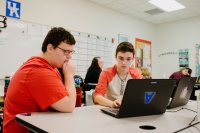Computational Thinking is Critical Thinking—and Belongs in Every Subject
Identifying patterns and groupings is a useful way of thinking not just for computer scientists but for students in all fields.
Your content has been saved!
Go to My Saved Content.Computational thinking, a problem-solving process often used by computer scientists, is not that different from critical thinking and can be used in any discipline, writes Stephen Noonoo in “Computational Thinking Is Critical Thinking. And It Works in Any Subject,” for EdSurge.
Elements of computational thinking, like pattern recognition, are easily transferred to unexpected areas of study like social studies or English, says Tom Hammond, a former teacher who is now an education professor at Lehigh University. Hammond says that students like the computational thinking approach because it’s engaging: “Ask yourself, would you rather get to play with a data set or would you rather listen to the teacher tell you about the data set?”
For example, in history classes students make use of data-rich, often open-source geographic information systems, or GIS, to plot election results from the colonial era to reimagine the way politics unfolded in the 1700s. These kinds of data visualization exercises offer a way for students to actively manipulate real-world information for deeper engagement and understanding.
There are three steps to bring computational thinking into your classroom, regardless of your subject area. First, consider the dataset. Hammond offers an example of incorporating computational thinking into a social studies class: A student is asked to give five state names which Hammond writes on the board. Then a different student lists five more states.
Once all the information is on the table, students execute the second step: identifying patterns. “Typically, this involves shifting to greater levels of abstraction—or conversely, getting more granular,” Noonoo writes. For students looking for commonalities or trends, this kind of critical thinking “cues them into the subtleties.” In the states example, students try to identify why Hammond grouped the states in the way he did. Is it by geography? Is it by what date they became part of the United States? Slowly, students begin to identify patterns—something the brain is already hardwired to do, according to Hammond.
In the final stage—decomposition—students break down information into digestible parts and then decide “What’s a trend versus what’s an outlier to the trend? Where do things correlate, and where can you find causal inference?” Establish a rule from the data—a process that requires that students make fine distinctions about how complex datasets can be reliably interpreted, Hammond says.
“It definitely took some practice to help them understand the difference between just finding a relationship and then a cause-and-effect relationship,” says Shannon Salter, a social studies teacher in Allentown, Pennsylvania, who collaborates with Hammond.
An entire curriculum can be dedicated to incorporating computational thinking, but that kind of “major overhaul” isn’t required, Hammond says. “It can be inserted on a lesson-by-lesson basis and only where it makes sense.”
Computational thinking is not that far afield from critical thinking. The processes mirror each other: “look at the provided information, narrow it down to the most valuable data, find patterns and identify themes,” Noonoo writes. Students become more agile thinkers when they exercise these transferrable skills in subjects not often associated with computer science, like history or literature.
